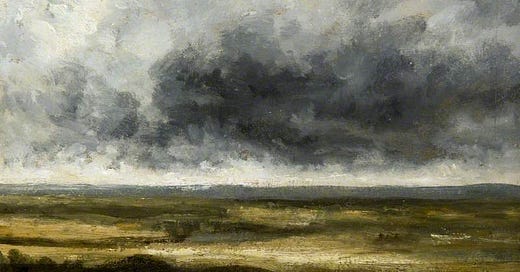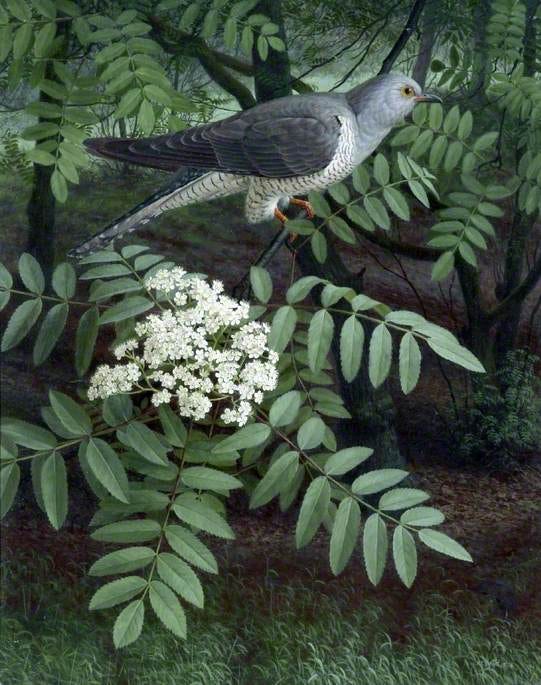Wuthering Heights would have been a far better romance if Heathcliff alone had been a being of stormy passions, instead of all the other characters being nearly as violent and destructive as himself.1
This observation (from an unsigned review of the novel reprinted in the Norton 5th edition), I have underlined and annotated with a resounding: Yes!
Is it not true? Literally every character is violent or destructive…more often, both.
Likely drawing on her observations of the natural world, Brontë characterizes humans as one might, animals. We are, after all. The actions of her characters seem unnatural, but in fact they behave no differently than most living things.
Displacement, mimicry, starvation, thievery, poisoning and often, death. All of these things exist outside our doors. Rooted in fertile soil, cloaked in iridescent feathers, or forming in billowing cumulus clouds above, devastation comes in all sorts of shapes and sizes.2
The Nature of Wuthering Heights
This week I noticed bindweed in our garden, its far-reaching tendril-leaves sneaking along the ground, winding their way up and around trunks and stems of every plant in its vicinity. Called by its common names, it might be characterized as charming (wild morning glory) or sinister (devil’s-vine). When I see bindweed emerge in the spring I am disheartened. It chokes and strangles everything with which it comes in contact. Pulling healthy plants down to the earth, it dominates a patch of ground and chokes out anything weaker.
Not unlike Heathcliff.
Rambling over our landscape, bindweed is rooted far and wide. An extensive, deep system of branched, fleshy rhizomes exists here—everywhere—unseen.
Invasive plants remind me of Ellen Dean.
In one 19th c. letter to the editor reviewing Wuthering Heights, a writer labeled Nelly, “an ordinary and mischievous housekeeper.” Bindweed is an ordinary weed. I mean, it’s no showy giant hogweed. It secretly encourages ruination. By the time we notice something we love is being dominated by the strong grip of its tendrils, it’s often too difficult to unravel. Ellen Dean sows similar seeds of discord between the Heights and the Grange.
From the moment old Earnshaw revealed a starving seven-year-old Heathcliff to his family, fourteen-year-old Nelly attempted to kick him from the nest. Instructed that the child be allowed to sleep in the children’s bedroom, Nelly instead left Heathcliff on the landing of the stairs, “hoping it might be gone tomorrow.”3
She is as bad-natured as they come.
Unlike an ousted nestling (starved and bullied), Heathcliff grows strong. He is not consumed by a passing feral cat or left to die from exposure. Instead, he grows and matures and sets down roots in the wild and unforgiving landscape to which he has been relocated.
Collected in Liverpool and planted at the Heights. Mr. Earnshaw carried him wrapped in an overcoat to a place sixty miles away. Where had he come from before he’d landed in Liverpool? Nobody knows. A burr in an overcoat. They viewed him as a non-native species. He did not belong. And so, they poisoned him.
All the Other Characters
The unnamed reviewer above believed Wuthering Heights would have been a far better romance if Heathcliff alone had been of stormy passions. When I discovered this 19th c review, I paused to think about ‘all the other characters.’
Mr. Lockwood is the first ‘violent and destructive’ character we meet—a gentleman from the south—he blunders into the Heights and during a nightmare, uses glass from a broken window pane to slice the wrist of a wailing ghost-child.
Terror made me cruel; and, finding it useless to attempt shaking the creature off, I pulled its wrist on to the broken pane, and rubbed it to and fro till the blood ran down and soaked the bedclothes...4
Emily Brontë introduces us to a handful of characters in the first three chapters and each one of them is detestable. If not for that Gothic romance teaser, we may not be inclined to continue reading, don’t you agree? Heathcliff is certainly not alluring. He is surly and morose. Vinegar-faced Joseph and lusty Zillah fail to arouse our interest. Hareton exhibits a vague humaneness but, Cathy comes off utterly disagreeable.
Moving deeper into the story we meet Hindley and Catherine Earnshaw and Edgar and Isabella Linton. Of the four, Edgar is the kindest and most gentle. The second generation is equally difficult to embrace:
Hindley is boorish. Cathy is haughty. Linton is well, Linton.
The Toxicity of Nelly Dean
Rhizomes contain all the nutrients which feed the plants and flowers we see on the surface, like the variegated Solomon’s seal growing in our woodland garden. Upright stalks of green and white leaves populate the ground, they live and grow in harmony with delicate rust-colored ‘Ellen Wilmott’ barrenwort. It, too, grows from a rhizome.
Sometimes rhizomes create beautiful tapestries. Some can even provide healing.
Each year I make a liniment from Solomon’s seal (for sore joints). It takes about 4-6 weeks. If you enjoy a slow read, you might enjoy slow herbalism. Here in the states a lot of people depend on tiny brown dropper bottles of volatile essential oils to heal themselves. They don’t understand the chemical properties of the plant, let alone any dangers associated with misuse of its concentrated actions.5
As my Solomon’s seal grows throughout the summer, its underground parts—the unseen—collect and store nutrients. In the fall, I collect these rhizomes and slice them into small pieces and using 100-proof alcohol to extract the plants’ healing properties, I make my liniment. Two simple healing ingredients.
This is called simpling. What happens if one ingredient is bad? Let’s say, I harvest the wrong plant or, I use an ineffective menstruum,6 my tinctures and liniments not only fail but present risks to my loved ones. Elder wine made using misidentified hemlock flowers, for example, presents a deadly unseen danger.
Nelly Dean is hemlock blooming amongst elderflowers. She poisons the entire novel and contributes to most of the dissension between characters.
Being of Stormy Passions
Hindley and Catherine are children of the storm.7 Emily Brontë does not explicitly illustrate the storm, though, does she? When we meet them as children, only young Catherine exhibits a ‘stormy passion.’ When asked what she might like as a souvenir from Liverpool, she desires a whip. She gets Heathcliff.
Fourteen-year-old Hindley wished for a fiddle. Should we assume he was the gentlest of the two siblings? Why does Brontë transform him into a brute? Nelly Dean claims Earnshaw, “took to Heathcliff strangely, believing all he said (for that matter, he said precious little, and generally the truth).”
Why does a creative and musical fourteen-year-old boy turn into a violent bully after his father introduces a reserved and honest seven-year-old boy to the nest?
Nelly is inaccurate when she characterizes Heathcliff as a cuckoo. Cuckoos practice brood parasitism. Heathcliff’s parents did not deposit him in the Earnshaw’s home; Mr. Earnshaw discovered an orphaned creature and rehoused it.
Cuckoos deposit an egg in the nest of another bird, usually a magpie, and are relieved of all parenting responsibilities. Heathcliff’s story is not a cuckoo’s; his parents never come looking for him. The cuckoo patrols the magpie’s nest and will even destroy it (or the host’s nestlings) to ensure the victim follows through on raising its young.8
Heathcliff was simply relocated. Heathcliff’s fellow nestlings were forced to share their resources (e.g., food), possessions (e.g., toys) and their father’s affection.
Before Heathcliff’s arrival, did Hindley and Catherine fight over such things?
According to Nelly, when they were children, she and Hindley stored snail-shells and pebbles in a hole near the bottom of a weather-worn block. Even though she was the daughter of the Earnshaw’s housekeeper, they were playmates. Mr. Earnshaw cared for her too—presenting her annually with a Christmas box.
Did Hindley and Catherine abuse Nelly—her mother quite literally deposited her in the Earnshaw’s nest—it seems to me she is more the cuckoo than Heathcliff?
Catherine is characterized as, “a wild, wick slip.” A slip is the young shoot of a plant. Nelly is describing her as young, lively and wild. Brontë tells us Cathy and Heathcliff would run away to the moors and remain there all day; but she never shows us. Aside from a glimpse or two during Cathy’s delirium, we must imagine how they spent their hours rambling.
After Earnshaw dies and Hindley becomes master of the Heights, both Catherine and Heathcliff exhibit stormy passions—they become unpredictable and destructive. Their fury comes up suddenly and the fallout is usually damaging.
The sullen, patient boy, subjected to harsh conditions, grew crooked and damaged.
Stormy passions and, the Earnshaws being children of the storm—our preconceived notion of romance versus literary definitions of romance—I’m really interested in these themes right now. If you are here with me. Thank you. ♡
Britannia, January 1848
“The average storm cloud has more energy than an atomic bomb…and lightning heats the air to approximately 54,000° F (30,000°C), six times hotter than the sun?” (Gooley, Tristan. The Secret World of Weather: How to Read Signs in Every Cloud, Breeze, Hill, Street, Plant, Animal, and Dewdrop. New York: The Experiment, 2021).
Brontë, Emily. Wuthering Heights: A Norton Critical Edition (Fifth Edition). Edited by Alexandra Lewis, 5th ed., W. W. Norton & Company, 2019, p. 21
ibid, 30
Essential oils are volatile; understand them before using them.
menstruum: solvent used to extract healing properties from plants
We have Wuthering Heights, the land of storm; high on the barren moorland, naked to the shock of the elements, the natural home of the Earnshaw family, fiery, untamed children of the storm.
On the other hand, sheltered in the leafy valley below, stands Thrushcross Grange, the appropriate home of the children of calm, the gentle, passive, timid Lintons (Cecil, David. Early Victorian Novelists: Essays in Revaluation. United Kingdom, Constable & Company, Limited, 1934).
The looming threat is referred to as mafia hypothesis; if the host fails to deliver on raising the cuckoos’ young, the host birds’ nest/young will potentially be destroyed.







Generally knowing that Wuthering Heights centered around Heathcliff and his nature, I was shocked to find that every character had their own violent and detestable nature. Don't we all, but theirs was on display for us woven by Bronte to perfectly subtle tale of consequence. I think it is also interesting that we only have Nelly's version of this tale where she is subtle in her catalystic destruction. Nice weaving of nature into this essay too!
I put down Wuthering heights last week after getting as far as when Isabel leaves Heathcliff. I came to it after reading Jane Eyre and Shirley and wanting to understand Emily better whom Shirley was based on.
You’re right about Nelly, she’s as toxic as the others but it’s just too much violence to continue. I’ll watch the film.